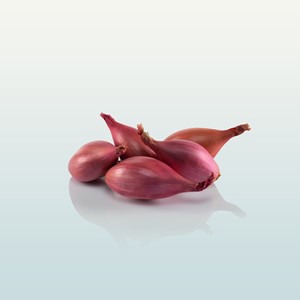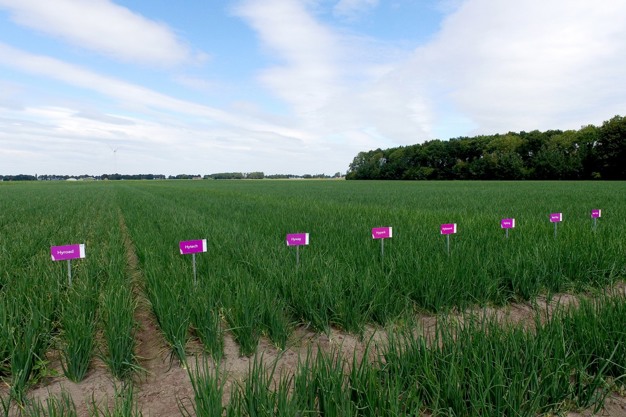With a genome five times larger than a human's and 16 times that of a tomato, it takes 15 years to develop a new variety. Believe it or not, we are talking about the humble onion. This seemingly simple bulb is hard to decipher. Lennaert Aardse of Dutch seed supplier De Groot en Slot delves into those depths every day and, here, peels some of the layers back for us.
Joint assessment of onion display by De Groot and Slot and Bejo.
We begin with shallots. With their oblong shape and individual character, they are a special member of the allium family. Like onions, the Netherlands is big in growing and exporting shallots to quite a few countries. De Groot en Slot, which in 1994 had a world first with the first generation of shallots from seed, has now, after 15 years of development in collaboration with partner Bejo, completed a third generation of these.
Innovator and day-long Conservor
Seed shallots? Is there any other type? Traditionally, especially in France, cultivating shallots from bulbs is still common practice. That is called vegetative propagation. A few bulbs from the harvest are not marketed but are kept to plant the following year. One such bulb produces several new shallots. Seed shallots, however, offer some advantages: they are easy to plant (well, sow), hybrid seeds purchased from seed suppliers are guaranteed disease- and virus-free and of consistent quality, and they generally store better.
"Innovator is our latest addition," says Lennaert, an onion breeder and producer in Seed Valley in the Netherlands. These are the first mildew-resistant seed shallots and, so, very suitable for organic cultivation where mildew is troublesome. Innovator is a welcome alternative to conventional products in supermarkets with stringent residue requirements, such as in France. And a crop that's less susceptible to foliar diseases also needs fewer plant protection products."
 Innovator is the first mildew-resistant seed shallot.
Innovator is the first mildew-resistant seed shallot.
Innovator, naturally, does not lack the typical shallot form. "It's slightly more elongated than our other long-day shallot, Conservor, so it fits very easily in the fresh produce bags. Innovator is somewhat more robust than Conservor, and its root system is even stronger. That offers growers security," says Lennaert.
Davidor for southern Spain
De Groot en Slot and Bejo's assortment includes a variety - Davidor - for cultivation in more southern areas where the days are shorter and different genetics are, thus, required. "It's what we call an intermediate shallot, which grows perfectly in, say, California, southern Spain, and even Morocco. The big advantage is that you can harvest these earlier in the season. True, the shorter-day segment's storage quality is usually a little inferior. The Conservor and the Innovator can be stored year-round; the Davidor, though, lasts only three to four months. You can still export them, but to avoid surprises, that needs good planning."
Lennaert doubts the southern countries pose a threat to France and the Netherlands' shallot market dominance. "It's a very specific crop. With Davidor, we have a good product in the range, but we see inexperienced growers struggle to take the first steps in shallot cultivation," he says. What is relevant for Southern European countries is even more so for Morocco and Egypt.
When it comes to many fruit and vegetable crops, these two countries are challenging countries like Spain and Italy. "Shallots don't suddenly grow faster in Morocco than in Spain or Italy. That's possible with onions, which is something else. But shallots are an exclusive product, so seeds are quite pricey. And cultivating from the bulb is even more expensive. France, for example, ships shallots to Morocco, but not the other way around."
Pink, white, red, and other colors
Unlike shallots, onions are a staple food in just about every country of the world. They come in several colors, with the yellow the most familiar. But they also come in pink, white, red, and even striped and fluorescent. Lennaert sees little demand for white onions in the Netherlands from either the (export) market or growers. "In France, except in the north, white onions thrive, but with the Dutch climate and heavy clay polder soil, often speckle those onions' skin gray. Their overall quality doesn't suffer, but it, of course, doesn't look nice. Should there be any demand, we already have our Icebear onion set ready to go," says Aardse.
In contrast, the red onion market is the largest in the world. "That's because it's widely consumed in India and China, together accounting for a population of almost three billion people. Demand for red onions among Dutch growers is increasing, and in recent years, their price has averaged higher than that of yellow onions. Quite a few containers of red onions are shipped from Dutch ports. And if India has a bad onion season, the Netherlands can't keep up with demand."There are various test fields of De Groot en Slot en Bejo all over the world.
Pink onions, in turn, are cultivated for the Dominican Republic, Senegal, and other West African countries. "The demand for that color is determined culturally; it has nothing to do with flavor. West Africa wants pink, Mexico likes white, and Asia prefers red. As a breeder, we naturally respond to market demand, but there's a whole range of possible colors, from deep purple and red and white striped to fluorescent yellow. You name it. However, demand for these specialties is lacking on the onion market, so it's not commercially interesting for us to invest in them," Lennaert explains.
First priority: a good root system
On to yellow, the most widely grown onion in the Netherlands. De Groot en Slot has a wide range of these, both in sets and seeds. "The biggest demand is for robust varieties with sturdy root systems and resistance to fungal diseases. That's because of climate change, where weather extremes increasingly impact cultivation. Think of droughts or sudden, heavy downpours."
"The traditional varieties, like the first Rijnsburgers, don't have a good root system, so they struggle to deal with Mother Nature's whims. Last year, Dutch growers sowed late, then it got extremely dry, and then we got a splash of water. Thanks to their strong root systems, varieties such as Hytune and Hysinger, two seed onion varieties we've been working on for 20 years, hold up well under such conditions," Lennaert points out.
Pinkroot and Fusarium resistance
Since breeding takes about 15 years, you must consider long-term growing and market conditions when developing new varieties. But who knows what will happen in the next two decades? "And yet we have no choice but to seriously consider that. For example, 12 years ago, there was no Pinkroot in the Netherlands. This soil fungus was, however, already present in Spain, and you could also see it popping up in southern France. We've been working for some time to make the Rijnsburg varieties Pinkroot-resistant, and lo and behold, the fungus is now also relevant in the Netherlands."
Lennaert explains that Dutch onion farming is increasingly moving away from the traditional cultivation areas, establishing itself in other regions. "That's partly to do with Pinkroot but mainly with Fusarium. Besides Hysky and Hygate, varieties with some resistance to Fusarium, we'll soon introduce a variety with decent resistance to both Fusarium and mildew. That's two birds with one stone. That gives growers battling Fusarium issues new hope," he continues.
 Test field with part of the Rijnsburger range.
Test field with part of the Rijnsburger range.
Saline soil
Also, salinization is an increasing problem requiring strong onions. "No specific resistances play a role, but again, the root system's strength is the determining factor. Certain parts of the Netherlands suffer from salinization, as do places like California and Murcia in Spain. Not coincidentally, we have research centers in those regions, too. Breeding ideally happens where demand comes from because onions are hugely daylength sensitive."
He adds that the search for saline-tolerant varieties has become part and parcel of the breeding program. "The Hacienda onion, for instance, is doing well in Venezuela in an area with enormous salinity. Our other varieties also appear to come out of the screenings quite successfully; that's where they distinguish themselves from our competitors. But, let's be honest; that 100% tolerance seems a long way off," the breeder says.
Skewed percentages
Most onions are free crops; there is little chain direction from the trade. "Growers are pretty free in their choice. Yet, in the Netherlands, where about 70% of onions are still loaded before Christmas, growers noticeably buy 80% long-storage variety seeds and grow 20% early, good-yielding onions. They're shipped before Christmas anyway."
"So, you'd expect at least 50% high-yielding varieties with medium storage conditions. In that respect, Hytune is an interesting variety, giving significantly higher yields per hectare than a storage variety. But, at the end of the day, I get it: growers don't want traders to put them on the spot. If buyers see the onions' quality decrease in storage, their bargaining power naturally increases," Lennaert adds.
And, says Lennaert, countries in the south, especially Spain and Morocco, no longer only grow onions with inferior storage quality. "In Spain you can grow Recas onions and easily store them for a year. However, that country prefers to focus on the local market. The Netherlands' export orientation is mainly because of the container surplus at the port of Rotterdam. All those containers from China can be returned empty or filled with something. Onions are highly suited to that. Spain doesn't have that logistical advantage."
China and Rwanda
To meet market demand for seeds, De Groot en Slot sets a five-year forecast. "Market demand for a variety doesn't suddenly rise overnight. We closely monitor the evolutions and adjust our production to the insights we gain," Lennaert explains. De Groot en Slot and Bejo have been Allium partners since 1970 and operate worldwide. Onion seeds go to China, where the company has quite a market share, among others, but also, for instance, Rwanda. "There, the DGS Foundation and Agriterra help local growers, who also increasingly want high-quality hybrid varieties. There's a growing demand for onions from every continent, even from countries you'd not immediately think of."
Display area of De Groot en Slot.
Most challenging crop
Knowing the onion genome is five times that of humans is partly thanks to the research efforts of De Groot and Slot in collaboration with specialists from Bejo and Wageningen University & Research. They managed to map the complete onion genome for the first time. And since onions have such complex genetics, Lennaert doubts CRISPR-Cas, a new genetic technique that can very specifically modify plant DNA, will revolutionize onion breeding any time soon.
"More is possible with the model crop, tomatoes. With onions, the color alone has quite an intricate pathway. Many different genes are involved, along with promoters that may or may not be on. We're trying to position all the known traits, so when breeding, you know exactly which chromosome to look out for when you do the various crossings."
What was the most surprising discovery when fully uncovering the genome? "We apparently specialized in the most challenging crop ever to breed," Lennaert concludes with a laugh.
Lennaert Aardse (Breeder)
[email protected]
Bart Schriever ( Benelux Sales Manager)
[email protected]
 De Groot en Slot B.V.
De Groot en Slot B.V.
Westelijke Randweg 1
1721 CH, Broek op Langedijk
The Netherlands
Tel.: +31 (0) 226 331 200
www.degrootenslot.nl
